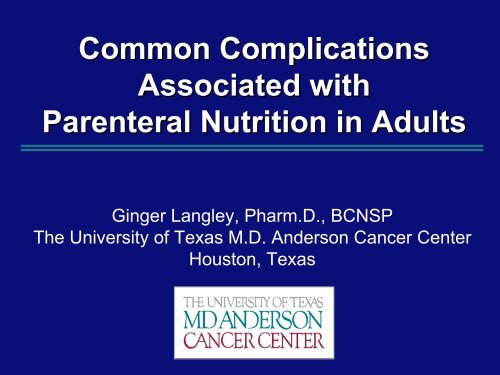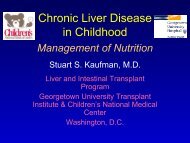Common Complications Associated with Parenteral Nutrition in Adults
Common Complications Associated with Parenteral Nutrition in Adults
Common Complications Associated with Parenteral Nutrition in Adults
- No tags were found...
Create successful ePaper yourself
Turn your PDF publications into a flip-book with our unique Google optimized e-Paper software.
<strong>Common</strong> <strong>Complications</strong><br />
<strong>Associated</strong> <strong>with</strong><br />
<strong>Parenteral</strong> <strong>Nutrition</strong> <strong>in</strong> <strong>Adults</strong><br />
G<strong>in</strong>ger Langley, Pharm.D., BCNSP<br />
The University of Texas M.D. Anderson Cancer Center<br />
Houston, Texas
• 57-year-old female <strong>with</strong> metastatic breast<br />
cancer and carc<strong>in</strong>omatosis<br />
• Chief compla<strong>in</strong>t of <strong>in</strong>creas<strong>in</strong>g abdom<strong>in</strong>al pa<strong>in</strong><br />
and persistent nausea and vomit<strong>in</strong>g<br />
• 25 pound weight loss <strong>in</strong> 2 months<br />
• TPN <strong>in</strong>itiated for surgical exploration
• 48-year-old male Type 2 diabetic<br />
s/p allogeneic bone marrow transplant<br />
• TPN <strong>in</strong>itiated secondary to severe GVHD<br />
• ICU admission further complicated by<br />
diffuse alveolar hemorrhage<br />
• Methylprednisolone 500mg IV daily x 3 days
• 38-year-old female <strong>with</strong> gastric outlet<br />
obstruction discharged on HPN<br />
• Discharge TPN formula <strong>in</strong>cludes 3 mL<br />
of M.T.E.-5<br />
• M.T.E.-5 Concentrated substituted for<br />
M.T.E.-5 to prepare for expected 3 month<br />
supply shortage of M.T.E.-5
<strong>Complications</strong> of<br />
<strong>Parenteral</strong> <strong>Nutrition</strong><br />
Mechanical<br />
Infectious<br />
Metabolic
Fluid and Electrolyte<br />
Imbalances<br />
Glucose<br />
Intolerance<br />
Micronutrient<br />
Deficiencies<br />
Metabolic<br />
<strong>Complications</strong><br />
Hepatic<br />
Steatosis<br />
Essential Fatty Acid<br />
Deficiency<br />
Metabolic<br />
Bone Disease
Refeed<strong>in</strong>g Syndrome<br />
• Severe electrolyte and fluid shifts associated<br />
<strong>with</strong> metabolic abnormalities <strong>in</strong> malnouished<br />
patients undergo<strong>in</strong>g feed<strong>in</strong>g<br />
• Potentially lethal condition<br />
• Hypophosphatemia no longer considered the<br />
predom<strong>in</strong>ant feature
Refeed<strong>in</strong>g Syndrome<br />
Cl<strong>in</strong>ical Features<br />
• Hypophosphatemia<br />
• Hypokalemia<br />
• Hypomagnesemia<br />
• Body fluid disturbances<br />
• Vitam<strong>in</strong> deficiency<br />
• Abnormalities <strong>in</strong> glucose metabolism
High-risk Patient Populations<br />
Kwashiorkor or marasmus<br />
Anorexia nervosa<br />
Chronic malnutrition<br />
Chronic alcoholism<br />
Prolonged fast<strong>in</strong>g<br />
Duodenal switch operation for obesity<br />
Hunger strikers<br />
Oncology patients<br />
Postoperative patients
Starvation/Malnutrition<br />
Gluconeogenesis<br />
Prote<strong>in</strong> Catabolism<br />
Weight Loss<br />
Refeed<strong>in</strong>g<br />
Syndrome<br />
Water/Vitam<strong>in</strong>/M<strong>in</strong>eral<br />
Depletion<br />
Thiam<strong>in</strong>e Utilization<br />
Refeed<strong>in</strong>g<br />
PO 4<br />
PO 4 Mg<br />
++<br />
Glucose<br />
K +<br />
Anabolism<br />
Pancreatic Insul<strong>in</strong> Release
Refeed<strong>in</strong>g Syndrome Cl<strong>in</strong>ical Manifestations<br />
Phosphorus<br />
Potassium<br />
Magnesium<br />
Cardiac<br />
X<br />
X<br />
X<br />
GI<br />
X<br />
X<br />
Hematologic<br />
X<br />
Hepatic<br />
X<br />
Neuromuscular<br />
X<br />
X<br />
X<br />
Respiratory<br />
X
Refeed<strong>in</strong>g Syndrome<br />
Cl<strong>in</strong>ical Manifestations<br />
• Weight ga<strong>in</strong><br />
– Total body water<br />
– Extracellular fluid volume<br />
• Hyperglycemia<br />
– Osmotic diuresis<br />
– Dehydration<br />
– Hypotension
• 57-year-old female <strong>with</strong> metastatic breast<br />
cancer and carc<strong>in</strong>omatosis<br />
• Chief compla<strong>in</strong>t of <strong>in</strong>creas<strong>in</strong>g abdom<strong>in</strong>al pa<strong>in</strong><br />
and persistent nausea and vomit<strong>in</strong>g<br />
• 25 pound weight loss <strong>in</strong> 2 months<br />
• TPN <strong>in</strong>itiated for surgical exploration
Refeed<strong>in</strong>g Syndrome<br />
Prevention and Management<br />
• Perform thorough nutritional assessment<br />
• Identify and correct electrolyte disorders<br />
prior to <strong>in</strong>itiation of parenteral nutrition<br />
• Start low and go slow <strong>with</strong> calories
Hyperglycemia<br />
• Well-known complication of parenteral<br />
nutrition <strong>with</strong> serious consequences<br />
• Strong correlation <strong>with</strong> rate of glucose<br />
<strong>in</strong>fusion <strong>in</strong> TPN<br />
• Adversely effects cl<strong>in</strong>ical outcome dur<strong>in</strong>g<br />
short-term hospitalization
Development of Hyperglycemia<br />
Insul<strong>in</strong> Deficiency<br />
Preexist<strong>in</strong>g DM<br />
Elderly<br />
Pancreatitis<br />
Excessive Dextrose<br />
Adm<strong>in</strong>istration<br />
Insul<strong>in</strong> Resistance<br />
Catecholam<strong>in</strong>e <strong>in</strong>fusions<br />
Corticosteroids<br />
Obesity<br />
Sepsis<br />
Uremia<br />
Cirrhosis
Hyperglycemia<br />
↑ INSULIN<br />
↑ Na & Water Reabsorption<br />
<strong>in</strong> proximal & distal tubule
Hyperglycemia<br />
↑ K Cellular Uptake<br />
Hypokalemia<br />
↑ INSULIN<br />
↑ Na & Water Reabsorption<br />
<strong>in</strong> proximal & distal tubule
Hyperglycemia<br />
↑ Intracellular Phosphate Shift<br />
Hypophosphatemia<br />
↑ K Cellular Uptake<br />
Hypokalemia<br />
↑ INSULIN<br />
↑ Na & Water Reabsorption<br />
<strong>in</strong> proximal & distal tubule
Hyperglycemia<br />
↑ Intracellular Phosphate Shift<br />
Hypophosphatemia<br />
↑ K Cellular Uptake<br />
Hypokalemia<br />
↑ INSULIN<br />
↑ Phosphate<br />
Reabsorption <strong>in</strong><br />
proximal tubule<br />
↑ Na & Water Reabsorption<br />
<strong>in</strong> proximal & distal tubule
Consequences of Hyperglycemia<br />
• Enhanced proteolysis<br />
• Decreased immune function<br />
• Increased <strong>in</strong>fections<br />
• Poor wound heal<strong>in</strong>g<br />
• Osmotic diuresis<br />
• Electrolyte disorders (pseudohyponatremia)
Who’s at risk for hyperglycemia<br />
• Obesity<br />
• Diabetes mellitus<br />
• Acute & chronic pancreatitis<br />
• Corticosteroid-dependent patients<br />
• SIRS & Sepsis<br />
• Drug-<strong>in</strong>duced
• 48-year-old male Type 2 diabetic<br />
s/p allogeneic BMT<br />
• TPN <strong>in</strong>itiated secondary to severe GVHD<br />
• ICU admission further complicated by<br />
diffuse alveolar hemorrhage<br />
• Methylprednisolone 500mg IV daily x 3 days
Hyperglycemia<br />
Prevention and Management<br />
• Identify and remove offend<strong>in</strong>g agents<br />
• Provide dextrose at appropriate rate<br />
– ≤ 4 mg/kg/m<strong>in</strong><br />
– Decrease TPN rate<br />
• Adm<strong>in</strong>ister more calories as fat<br />
• Add <strong>in</strong>sul<strong>in</strong> to TPN<br />
– 1 unit/10g dextrose for nondiabetics<br />
– 1 unit/ 5g dextrose for diabetics
Micronutrient Abnormalities<br />
• Z<strong>in</strong>c deficiency<br />
• Copper deficiency<br />
• Selenium deficiency<br />
• Chromium deficiency<br />
• Manganese <strong>in</strong>toxication
Z<strong>in</strong>c Deficiency<br />
• Risk factors<br />
– Hypercatabolism<br />
– Excessive diarrhea<br />
• Requirement<br />
– Normal stool losses: 6 mg/day<br />
– Short bowel syndrome: 12 – 20 mg/day<br />
• Presents as perioral postural rash, alopecia,<br />
darken<strong>in</strong>g of sk<strong>in</strong> creases, and neuritis
Copper Deficiency<br />
• Excessive diarrhea is a risk factor<br />
• Presents as microcytic anemia often<br />
mistaken for pyridox<strong>in</strong>e deficiency<br />
• Adm<strong>in</strong>ister up to 2mg/day of copper as<br />
sulfate salt <strong>in</strong> deficient states<br />
• Liver disease reduces biliary excretion<br />
and lowers requirement
Selenium Deficiency<br />
• Cl<strong>in</strong>ical manifestations are rarely seen<br />
• Requirements dur<strong>in</strong>g parenteral nutrition<br />
– <strong>Adults</strong>: 50 – 60 mcg/day<br />
– Children: 1 – 4 mcg/kg/day<br />
• Symptoms: skeletal myalgias and<br />
myopathy, hair depigmentation, nail<br />
streak<strong>in</strong>g, and dilated cardiomyopathy
Chromium Deficiency<br />
• Patients on long-term TPN <strong>with</strong> little or<br />
no oral <strong>in</strong>take at highest risk<br />
• Requirements<br />
– Daily: 15 – 20 mcg/day<br />
– Deficiency: 150 mcg/day for several days<br />
• Manifestations: difficult blood glucose<br />
control, peripheral neuropathy, and<br />
encephalopathy
Manganese Intoxication<br />
• Patients <strong>with</strong> significant hepatobiliary disease<br />
at highest risk<br />
• Cl<strong>in</strong>ical presentation<br />
– Park<strong>in</strong>sonian-like symptoms<br />
• Muscular weakness, stiffness<br />
• Tremors, ataxia, abnormal gait<br />
– Psychological changes<br />
• Mental irritability, headaches<br />
• Nervousness, compulsive actions, halluc<strong>in</strong>ations
Manganese Intoxication<br />
• Cl<strong>in</strong>ical symptom severity depends on<br />
– <strong>Parenteral</strong> dose<br />
– Duration of therapy<br />
– Extent of liver disease<br />
–Age<br />
• Adult requirements<br />
– Acute sett<strong>in</strong>g: 0.15 – 0.8 mg/day<br />
– Long-term sett<strong>in</strong>g: 0.1 – 0.3 mg/day
• 38-year-old female <strong>with</strong> gastric outlet<br />
obstruction discharged on HPN<br />
• Discharge TPN formula <strong>in</strong>cludes 3 mL<br />
of M.T.E.-5<br />
• M.T.E.-5 Concentrated substituted for<br />
M.T.E.-5 to prepare for expected 3 month<br />
supply shortage of M.T.E.-5
Manganese Intoxication<br />
Prevention and Management<br />
• Remove supplemental manganese from<br />
parenteral solutions <strong>in</strong> patients <strong>with</strong> liver<br />
disease<br />
• Avoid us<strong>in</strong>g trace-element concentrate <strong>in</strong><br />
long-term adult patients<br />
• Supplement micronutrient deficiencies <strong>with</strong><br />
s<strong>in</strong>gle-entity products<br />
• Monitor blood manganese levels <strong>in</strong> long-term<br />
HPN patients
Summary<br />
• Most complications associated <strong>with</strong><br />
parenteral nutrition are easily prevented or<br />
treated due to advances <strong>in</strong> modern medic<strong>in</strong>e.<br />
• Nonetheless, hyperglycemia and catheterrelated<br />
sepsis still occur.<br />
• Early identification of severely malnourished<br />
patients and appropriate monitor<strong>in</strong>g regimens<br />
are critical <strong>in</strong> reduc<strong>in</strong>g complications<br />
associated <strong>with</strong> parenteral nutrition.
<strong>Adults</strong> - <strong>Common</strong> <strong>Complications</strong> <strong>Associated</strong> <strong>with</strong> <strong>Parenteral</strong> <strong>Nutrition</strong><br />
G<strong>in</strong>ger Langley PharmD<br />
The University of Texas M.D. Anderson Cancer Center<br />
Houston, TX<br />
Learn<strong>in</strong>g Objectives<br />
Upon completion of this session, the participant will be able to:<br />
1. Identify the risk factors and cl<strong>in</strong>ical features of the refeed<strong>in</strong>g syndrome.<br />
2. Describe methods to prevent and manage hyperglycemia associated <strong>with</strong> parenteral nutrition.<br />
3. Discuss micronutrient abnormalities associated <strong>with</strong> acute and chronic parenteral nutrition.<br />
I. <strong>Complications</strong> of <strong>Parenteral</strong> <strong>Nutrition</strong><br />
A. Mechanical<br />
B. Infectious<br />
C. Metabolic<br />
II.<br />
Refeed<strong>in</strong>g Syndrome<br />
A. Cl<strong>in</strong>ical features<br />
B. High-risk patient populations<br />
C. Prevention and management<br />
III. Hyperglycemia<br />
A. Etiologies<br />
B. Adverse effects<br />
C. Prevention and management<br />
IV. Micronutrient Abnormalities<br />
A. Z<strong>in</strong>c deficiency<br />
B. Copper deficiency<br />
C. Selenium deficiency<br />
D. Chromium deficiency<br />
E. Manganese <strong>in</strong>toxication<br />
Self-Assessment Questions<br />
1. All of the follow<strong>in</strong>g electrolyte abnormalities are present <strong>with</strong> the refeed<strong>in</strong>g syndrome except:<br />
a. Hypokalemia<br />
b. Hypophosphatemia<br />
c. Hypomagnesemia<br />
d. Hypouricemia<br />
2. Hyperglycemia secondary to <strong>in</strong>itiation of TPN <strong>in</strong> most patients can be managed by add<strong>in</strong>g 0.1 units<br />
of <strong>in</strong>sul<strong>in</strong> to the TPN for every gram of dextrose.<br />
a. True<br />
b. False<br />
3. All of the follow<strong>in</strong>g are risk factors for the development of manganese <strong>in</strong>toxication except:<br />
a. Age<br />
b. Hepatobiliary disease<br />
c. High-dose parenteral manganese supplementation<br />
d. Renal failure
References<br />
Refeed<strong>in</strong>g Syndrome<br />
1. Solomon SM, Kirby DF. The refeed<strong>in</strong>g syndrome: A review. JPEN 1990; 14:90-97.<br />
2. Crook MA, Hally V, Panteli JV. The importance of the refeed<strong>in</strong>g syndrome. <strong>Nutrition</strong> 2001;17:632-637.<br />
3. Brooks MJ, Melnik G. The refeed<strong>in</strong>g syndrome: An approach to understand<strong>in</strong>g its complications and prevent<strong>in</strong>g its<br />
occurrence. Pharmacotherapy 1995;15:713-726.<br />
Hyperglycemia<br />
1. McMahon M, Manji N, Driscoll DF, et al. <strong>Parenteral</strong> nutrition <strong>in</strong> patients <strong>with</strong> diabetes mellitus: Theoretical and<br />
practical considerations. JPEN 1989;13:196-204.<br />
2. McMahon MM. Management of hyperglycemia <strong>in</strong> hospitalized patients receiv<strong>in</strong>g parenteral nutrition. NCP<br />
1997;12:35-41.<br />
3. Schloerb PR, Henn<strong>in</strong>g JF. Patterns and problems of adult total parenteral nutrition use <strong>in</strong> US academic medical<br />
centers. Arch Surg 1998;133:7-12.<br />
4. Montori VM, Bistrian BR, McMahon MM. Hyperglycemia <strong>in</strong> acutely ill patients. JAMA 2002;288:2167-2169.<br />
Micronutrient Abnormalities<br />
1. Sudhakar M, Kirby DF. Micronutrient and trace element monitor<strong>in</strong>g <strong>in</strong> adult nutrition support. NCP 2000;15:120-<br />
126.<br />
2. Baumgartner TG. Trace elements <strong>in</strong> cl<strong>in</strong>ical nutrition. NCP 1993;8:251-263.<br />
3. McCla<strong>in</strong> CJ. Trace metal abnormalities <strong>in</strong> adults dur<strong>in</strong>g hyperalimentation. JPEN 1981;5:424-429.<br />
4. Dickerson RN. Manganese <strong>in</strong>toxication and parenteral nutrition. <strong>Nutrition</strong> 2001;17:689-693.<br />
Answers to Self-Assessment Questions, Rationale and References<br />
1. The correct answer is d. Hypouricemia.<br />
Ma<strong>in</strong> pathophysiologic features of the refeed<strong>in</strong>g syndrome are: abnormalities of fluid balance,<br />
abnormalities of glucose metabolism, vitam<strong>in</strong> deficiency, hypophosphatemia, hypomagnesemia,<br />
and hypokalemia.<br />
<strong>Nutrition</strong> 2001;17:632-637.<br />
2. The correct answer is a. True.<br />
Most diabetic patients need supplemental <strong>in</strong>sul<strong>in</strong> when glucose is <strong>in</strong>fused. For patients previously<br />
treated <strong>with</strong> <strong>in</strong>sul<strong>in</strong> or oral agents or for patients <strong>with</strong> a fast<strong>in</strong>g glucose greater than 180 to 200<br />
mg/dL, a basal amount of Human Regular <strong>in</strong>sul<strong>in</strong> is added to dextrose-conta<strong>in</strong><strong>in</strong>g PN solutions.<br />
Insul<strong>in</strong> at 0.1 unit per gram of dextrose is our start<strong>in</strong>g po<strong>in</strong>t.<br />
NCP 1997;12:35-41.<br />
3. The correct answer is d. Renal failure.<br />
Manganese is elim<strong>in</strong>ated predom<strong>in</strong>antly through the hepatobiliary system. The literature suggests<br />
that the presence of hypermanganesemia and the cl<strong>in</strong>ical symptoms from manganese toxicity<br />
depend on the dose of parenteral manganese, duration of use, and the presence of significant liver<br />
disease. Others have suggested age as risk factor for development of toxicity, <strong>with</strong> <strong>in</strong>fants,<br />
children, and older adults be<strong>in</strong>g more susceptible to manganese toxicity.<br />
<strong>Nutrition</strong> 2001;17:689-693.





